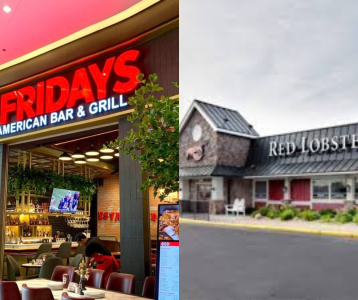Popular Eateries Shutting Their Doors! You Won't Believe What Will Replace Red Lobster and TGI Fridays!
By
Michelle E.
- Replies 0
As the sun sets on some of America's beloved dining establishments, a new dawn breaks for a variety of businesses ready to breathe fresh life into these familiar spaces.

But with every goodbye comes the arrival of a new beginning. Is there a new place for everyone to fill with memories? Let’s see what the new places on the block have in store for us!
The Changing Landscape of American Dining
In Woodbridge, Virginia, the savory aroma of TGI Fridays' Jack Daniel's ribs will give way to the sizzle of LongHorn Steakhouse's steaks. Meanwhile, in Watertown, New York, where seafood once reigned, a Northern Credit Union bank will now anchor the community's financial needs. And in Naples, Florida, the former home of Red Lobster's cheddar bay biscuits will soon be serving up Chick-fil-A's famous chicken sandwiches.
These transformations are a sign of the times. Vacant restaurant chains are becoming prime real estate for a wide array of companies, particularly fast-food chains eager to expand their drive-thru presence. It's a trend that reflects a shift in consumer habits, with diners increasingly favoring the convenience of fast-food and fast-casual dining over traditional sit-down experiences.

The Fall of Familiar Favorites
The closures of Red Lobster and TGI Fridays are part of a larger narrative. Both chains have filed for bankruptcy, with Red Lobster struggling with mismanagement issues under its former owner, Thai Union, and TGI Fridays falling under the ownership of private equity firm TriArtisan Capital Advisors. Denny's, another staple of American dining, is also downsizing, with plans to close 150 restaurants.
These establishments, once catering to low and middle-income patrons, have found themselves squeezed by changing consumer preferences. Many diners are opting to eat at home or choose more affordable fast-food options. According to Denny's CEO Kelli Valade, “family dining has been hit hardest post-pandemic, with customer traffic to full-service restaurants like Denny's dropping slightly, while fast-casual and fast-food establishments have seen increases.”
A New Lease on Life
Landlords are seizing the opportunity to revitalize these locations with new tenants who can offer higher rent and attract more customers. Jeff Kreshek, a senior vice president at Federal Realty, views this as a chance to introduce these properties to the market for the first time in decades.
The drive-thru revolution is in full swing, with fast-food and fast-casual chains like Chipotle and Chick-fil-A taking over these spaces to build more efficient drive-thru lanes. These locations are often more profitable due to their smaller size and reduced staffing and maintenance requirements.
Even smaller dining chains are getting in on the action. Fogo De Chao and First Watch, a breakfast chain, are expanding into former restaurant sites. First Watch, in particular, has opened several new restaurants in previous Red Lobster and TGI Fridays locations, with plans to continue this growth.
The Appeal of Vacant Restaurants
Finding vacant space or constructing a new restaurant from scratch is challenging in the current market. With a low US retail vacancy rate and a tight supply of available spaces, these former restaurant locations are hot commodities. These locations are selling fast because of the possibility of growth for companies, since customers are already familiar with the area. They also offer attractive features such as freestanding buildings, high-traffic street locations, ample parking, and proximity to shopping centers.
As the retail landscape evolves, with indoor malls facing their own set of challenges, these standalone restaurant sites are becoming increasingly desirable for businesses looking to expand.
But not every restaurant is experiencing an “out with the old and in with the new” facelift. For some, their oldies remain goodies, thus leading to a return for crowd favorites. In particular, KFC’s famous recipe entered the market once again. Read more about this exciting comeback in this story.

Change is inevitable, but it also brings new opportunities. As we bid farewell to the old, let's embrace the new experiences that await us in these familiar spaces.
Before moving forward, let’s take a moment to remember the warmth these establishments brought to our lives. What were your best memories at these restaurants? What are the dishes you’ll miss the most? Are there any special moments you created at either of these restaurants? We invite you to share your memories of Red Lobster's seafood feasts or TGI Fridays' lively atmosphere in the comments below.

Two beloved establishments meet their end in some locations. Image source: Opus Mall and Red Lobster via Facebook.
But with every goodbye comes the arrival of a new beginning. Is there a new place for everyone to fill with memories? Let’s see what the new places on the block have in store for us!
The Changing Landscape of American Dining
In Woodbridge, Virginia, the savory aroma of TGI Fridays' Jack Daniel's ribs will give way to the sizzle of LongHorn Steakhouse's steaks. Meanwhile, in Watertown, New York, where seafood once reigned, a Northern Credit Union bank will now anchor the community's financial needs. And in Naples, Florida, the former home of Red Lobster's cheddar bay biscuits will soon be serving up Chick-fil-A's famous chicken sandwiches.
These transformations are a sign of the times. Vacant restaurant chains are becoming prime real estate for a wide array of companies, particularly fast-food chains eager to expand their drive-thru presence. It's a trend that reflects a shift in consumer habits, with diners increasingly favoring the convenience of fast-food and fast-casual dining over traditional sit-down experiences.

Americans’ preferences in dining are quickly changing, especially post-pandemic. Image source: Pexels.
The Fall of Familiar Favorites
The closures of Red Lobster and TGI Fridays are part of a larger narrative. Both chains have filed for bankruptcy, with Red Lobster struggling with mismanagement issues under its former owner, Thai Union, and TGI Fridays falling under the ownership of private equity firm TriArtisan Capital Advisors. Denny's, another staple of American dining, is also downsizing, with plans to close 150 restaurants.
These establishments, once catering to low and middle-income patrons, have found themselves squeezed by changing consumer preferences. Many diners are opting to eat at home or choose more affordable fast-food options. According to Denny's CEO Kelli Valade, “family dining has been hit hardest post-pandemic, with customer traffic to full-service restaurants like Denny's dropping slightly, while fast-casual and fast-food establishments have seen increases.”
A New Lease on Life
Landlords are seizing the opportunity to revitalize these locations with new tenants who can offer higher rent and attract more customers. Jeff Kreshek, a senior vice president at Federal Realty, views this as a chance to introduce these properties to the market for the first time in decades.
The drive-thru revolution is in full swing, with fast-food and fast-casual chains like Chipotle and Chick-fil-A taking over these spaces to build more efficient drive-thru lanes. These locations are often more profitable due to their smaller size and reduced staffing and maintenance requirements.
Even smaller dining chains are getting in on the action. Fogo De Chao and First Watch, a breakfast chain, are expanding into former restaurant sites. First Watch, in particular, has opened several new restaurants in previous Red Lobster and TGI Fridays locations, with plans to continue this growth.
The Appeal of Vacant Restaurants
Finding vacant space or constructing a new restaurant from scratch is challenging in the current market. With a low US retail vacancy rate and a tight supply of available spaces, these former restaurant locations are hot commodities. These locations are selling fast because of the possibility of growth for companies, since customers are already familiar with the area. They also offer attractive features such as freestanding buildings, high-traffic street locations, ample parking, and proximity to shopping centers.
As the retail landscape evolves, with indoor malls facing their own set of challenges, these standalone restaurant sites are becoming increasingly desirable for businesses looking to expand.
But not every restaurant is experiencing an “out with the old and in with the new” facelift. For some, their oldies remain goodies, thus leading to a return for crowd favorites. In particular, KFC’s famous recipe entered the market once again. Read more about this exciting comeback in this story.
Key Takeaways
- Several restaurant chains, including Red Lobster and TGI Fridays, have closed locations due to bankruptcy, which is creating opportunities for other businesses to take over prime real estate.
- Fast-food and fast-casual chains, like Chick-fil-A, Chipotle, and drive-thru focused businesses, are moving into these vacated spaces due to the profitability of drive-thru service over traditional sit-down dining.
- The decline of family dining post-pandemic has seen customer traffic shift away from full-service restaurants like Denny’s to fast-casual and fast-food restaurants which offer quicker, more affordable dining options.
- Vacant restaurant locations are highly sought after in the current market as they are often well-situated on high-traffic streets with ample parking, making them ideal for fast-food chains and other businesses looking to expand.
Change is inevitable, but it also brings new opportunities. As we bid farewell to the old, let's embrace the new experiences that await us in these familiar spaces.
Before moving forward, let’s take a moment to remember the warmth these establishments brought to our lives. What were your best memories at these restaurants? What are the dishes you’ll miss the most? Are there any special moments you created at either of these restaurants? We invite you to share your memories of Red Lobster's seafood feasts or TGI Fridays' lively atmosphere in the comments below.







